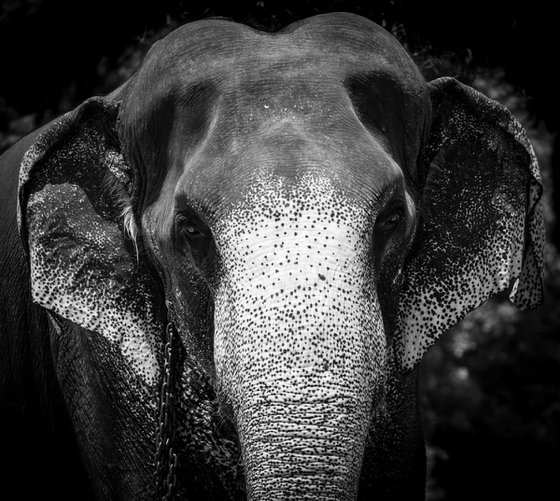- By medium
- By subject
- By budget
- Sales
- Gift cards
- Discover all art
- Artists
- Editors’ picks
- Ideas
Artwork description:
The Sri Lankan subspecies is the largest and also the darkest of the Asian elephants, with patches of depigmentation—areas with no skin color—on its ears, face, trunk and belly. Once found throughout the tear-shaped island at the bottom of India’s southern tip, these elephants are now being pushed into smaller areas as development activities clear forests and disrupt their ancient migratory routes._x000D_
_x000D_
The herd size in Sri Lanka ranges from 12-20 individuals or more. It is led by the oldest female, or matriarch. In Sri Lanka, herds have been reported to contain nursing units, consisting of lactating females and their young, and juvenile care units, containing females with juveniles. The Sri Lankan elephant population has fallen almost 65% since the turn of the 19th century. Today, the Sri Lanka elephant is protected under the Sri Lankan law and killing one carries the death penalty._x000D_
_x000D_
Source WWF
Materials used:
Giclée print using pigment inks on Hahnemühle Baryta FB paper.
Tags:
#black and #elephant #sri lanka #wild life #safari art #india elephantsIndian Elephant - Sri Lanka (2019) Photograph
by Stephen Hodgetts Photography
14 Artist Reviews
£95
- Photograph on Paper
- From a limited edition of 25
- Size: 42.01 x 29.69cm (unframed) / 25 x 25cm (actual image size)
- Signed and numbered on the front
- Style: Photorealistic
- Subject: Animals and birds
Loading
Artwork description
The Sri Lankan subspecies is the largest and also the darkest of the Asian elephants, with patches of depigmentation—areas with no skin color—on its ears, face, trunk and belly. Once found throughout the tear-shaped island at the bottom of India’s southern tip, these elephants are now being pushed into smaller areas as development activities clear forests and disrupt their ancient migratory routes._x000D_
_x000D_
The herd size in Sri Lanka ranges from 12-20 individuals or more. It is led by the oldest female, or matriarch. In Sri Lanka, herds have been reported to contain nursing units, consisting of lactating females and their young, and juvenile care units, containing females with juveniles. The Sri Lankan elephant population has fallen almost 65% since the turn of the 19th century. Today, the Sri Lanka elephant is protected under the Sri Lankan law and killing one carries the death penalty._x000D_
_x000D_
Source WWF
Materials used:
Giclée print using pigment inks on Hahnemühle Baryta FB paper.
Tags:
#black and #elephant #sri lanka #wild life #safari art #india elephants14 day money back guaranteeLearn more

